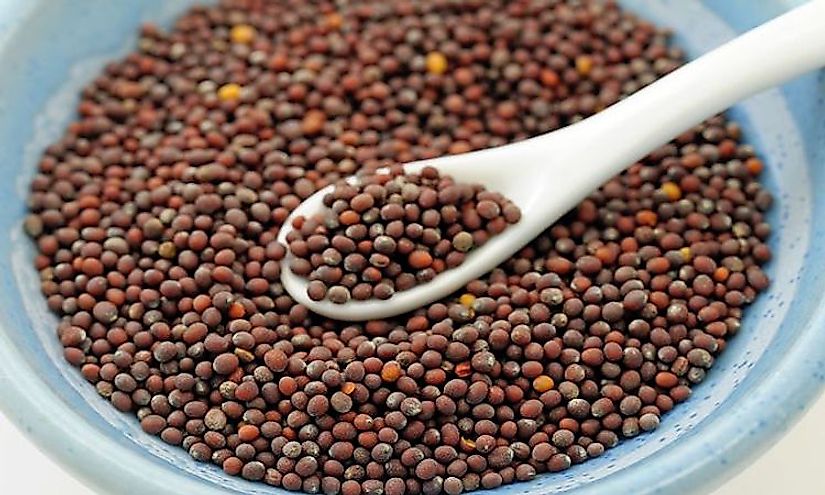Where Do Mustard Seeds Come From?

Mustard seed, as its name suggests, are the small seeds of the mustard plant. These 1 to 2-millimeter seeds can be found in several colors, depending on the plant. These plants include black mustard, brown Indian mustard, and white mustard. Interestingly, this seed was once referred to as “eye of newt”, which has led to the belief that real newt eyes were used in some recipes. This idea was made more common in a famous line from the Macbeth play, written by Shakespeare. This article takes a closer look at mustard seed cultivation and production, as well as the world’s top producers.
Mustard Seed Cultivation
Mustard seeds require a cold climate and moist soil to germinate, which takes between 3 and 10 days. When allowed to mature, the mustard plant grows into a shrub-like plant. Around 1 month to 1.5 months after germination, the mustard plant flowers. These flowers can be seen for around 2 weeks before they become pods over a 35 to 45-day period. Once the pods turn brown, the seeds are ready. In total, mustard plants take approximately 3 months to produce seeds. The black and brown varieties produce a higher quantity of seeds than the yellow mustard plant.
Depending on the water content of harvested seeds, cultivators may place them on mesh screens to dry out slightly. Others harvest the plant and hang it upside down until it releases the seeds into a collection container below.
Uses For Mustard Seed
Mustard seed has been used since ancient times. The earliest mention of the mustard seed dates back to a 5th century BC story from India about Gautama Buddha. Its most well-known use is in the preparation of mustard, when the seed is ground and mixed with water or vinegar to create a paste. Mustard is used as a condiment for many dishes, including as a topping for hamburgers and hot dogs. Throughout several countries, including India and Nepal, mustard seed is used as a spice. In powdered form mixed with mustard oil, it becomes the base for a traditional Indian pickle recipe. The seed is also roasted and used as a spicy element in many other dishes.
World’s Top Producers Of Mustard Seed
So where is mustard seed produced? Below is a look a some of the world’s top mustard seed producing countries.
Nepal
Nepal is the world's top mustard seed producer. 159,710 tonnes were produced in 2017. This number represents around 26% of the world supply. Despite this large percentage, Nepal does not make the top 5 list of biggest exporters. This indicates that the vast majority of the mustard seed cultivated here remains in the country.
Canada
Canada is the world's other major producer of mustard seed. In 2017, the country produced around 121,600 tons. This number represents approximately 28% of the world mustard seed supply. The majority of these seeds are produced in the province of Alberta, followed by Saskatchewan. Not surprisingly, Canada is the world’s largest mustard seed exporter as well. In fact, this country holds a 57% share of the market.
The World's Top Mustard Seed Producing Countries
| Rank | Area | Value |
|---|---|---|
| 1 | Nepal | 159,710 |
| 2 | Canada | 121,600 |
| 3 | Russia | 98,319 |
| 4 | Myanmar | 42,760 |
| 5 | Ukraine | 31,000 |
| 6 | United States of America | 27,330 |
| 7 | China | 18,415 |
| 8 | Kazakhstan | 15,121 |
| 9 | France | 14,160 |
| 10 | Czechia | 9,542 |







